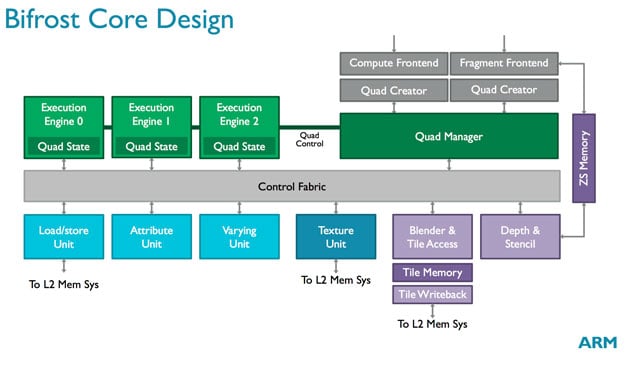ARM Cortex-A73 Taps 10nm FinFET And Burly Mali-G71 GPU For Smartphone VR Revolution
Mali-G71 Is The First In A New Family Of 'Laptop Class' GPUs
On the GPU front, the new Mali-G71 introduces a brand new architecture, codenamed Bifrost. ARM says that Mali-G71 is its highest performing GPU to date and brings with it a more efficient core architecture, a redesigned shader core with new clause-based ISA, quad-based arithmetic units, and new core fabric, in addition to full coherency, and new geometry flow to reduce the memory footprint.
The Bifrost architecture uses quad-parallel execution, which executes four scaler threads simultaneously. Each thread is capable of filling a single 32-bit lane, while four threads performing a vec3 FP32 calculation can do so in three cycles. ARM says that this quad vectorization is “compiler friendly” and that vector operations can always be split up into scalers if the need arises, and it helps contribute to an overall increase in power efficiency.
Bifrost also has some significant changes to the tiler that was used in the previous generation architecture used by Mali-T880, which was codenamed Midgard. Tiler memory structures have been redesigned to eliminate minimum buffer allocations, while buffer allocation granularity has received finer-grain controls. These changes along with compression technologies and other modifications to the tiler have resulted in up to a 95 percent reduction in the tiler memory footprint.
Google is looking to push the envelope in virtual reality performance on the smartphone form-factor with the Daydream platform for Android, so pushing the performance envelope with the Mali-G71 is paramount. The Mali-G71 increases raw processing power by doubling the number of possible shader cores from 16 to 32 over previous-gen offerings. And with all of the architectural improvements that have been made with Bifrost, the Mali-G71 GPU provides up to a 50 percent performance boost over the previous generation, high-end Mali-T880. Likewise, external DRAM bandwidth and energy efficiency have both been increased by 20 percent.
ARM says that Mali-G71 offers performance parity with some of the discrete GPUs in 2015-era laptops in the GFXBench 4.0 1080p Manhattan 3.1 off-screen benchmark. However, ARM didn’t specify which laptop GPU it was referencing, so we can take those figures with a grain of salt until we can perform our own benchmarks.
And as you might expect, Mali-G71 fully supports the OpenCL 2.0 and Vulkan APIs, and was built from the ground-up to optimally support virtual reality and augmented reality. As such, it supports, 120Hz refresh rates, 4K screens (just in time for Samsung’s 5.5-inch 4K display), and 4x multi-sample antialiasing. Pipeline latency and driver efficiency is improved as well.
ARM feels that the combination of Cortex-A73 with Mali-G71 will provide smartphone users with the best possible mobile experience when SoCs ship later in the year; especially with the big push towards higher resolution displays and virtual reality. With that in mind, we should see the first devices powered by Cortex-A73 shipping at the end of 2016 or early in 2017. And when those flagship devices start hitting store shelves, rest assured, we’ll be lying in wait to put them through our benchmark regimen.










